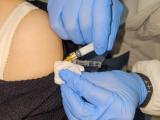Jun 18, 2010 (CIDRAP News) – Federal officials looked to the relatively new model of school-based immunization clinics as an efficient way to deliver the pandemic vaccine to children, and a report from clinic observers detailed that the process worked well, though most schools would need more resources to hold future clinics.
When the novel H1N1 flu virus emerged last April, only a few school districts such as those in Hawaii, East Baton Rouge, La., Knox County, Tenn., and Aurora, Colo., had ever conducted flu immunization clinics.
Before the flu pandemic, momentum had been building for school-based clinics, especially after vaccine advisors for the US Centers for Disease Control and Prevention (CDC) in February 2008 expanded their flu vaccine recommendation to include all schoolchildren. They previously focused the recommendation on preschoolers.
Early evidence showed that pandemic H1N1 virus was taking a greater toll on children, and in July 2009 the CDC's vaccine advisors placed young people ages 6 months through 24 years old in its priority group to receive the first doses of the vaccine, which focused attention on school-based vaccine clinics as an ideal delivery tool to reach large numbers of children.
Given the relative newness of the school-based vaccine clinic model, the CDC said it would be useful to evaluate administration of the pandemic vaccine at school-based sites. In response, the US Department of Health and Human Services (HHS) Office of Inspector General (OIG) conducted on-site reviews in November and December 2009 at 38 elementary school–based clinics in six localities.
Federal officials released the OIG findings on Jun 16 in a 32-page report. The goals of the study were to determine the extent of vaccination, how sites administered the clinics, and what lessons schools learned from the experience.
The OIG said most states prioritized young people between ages 6 months and 24 years to receive the vaccine, and 40 of them used school-based vaccine programs to some extent to reach the group.
Investigators based their clinic evaluations on five elements: ensuring proper vaccine storage, distributing consent forms and verifying eligibility, staffing, parent communications, and billing for vaccine administration.
They found that sites vaccinated an average of 28% of enrolled students during 1-day programs, which federal officials said compares favorably with state and national vaccination rates. For example, the average vaccination rate for the six states included in the study is 37%, which reflects a child vaccination period of about 3 months at multiple sites such as doctor's offices, pharmacies, and community clinics. Most of the 38 locations said the school-based clinics were a useful vaccination method but said they would not hold them in the future without additional resources.
About 42% of the children vaccinated at the sites received the nasal mist form of the vaccine, and 59% received the injection. Reviewers noted that three of the six localities reported decreased demand for the nasal mist version, due to parent and staff misconceptions about its safety, which were driven by incorrect media messages that the nasal mist was riskier because it contained a live attenuated virus.
Most school sites used recommended vaccine storage containers, but only half monitored the temperature of the cooler or refrigerator as recommended.
All locations used parental consent forms to verify student eligibility, though most said they would revise the procedures for future vaccine clinics. Some said they needed more staff available to call parents to verify some of the information on the form. Others said they would reformat the form for varying parent reading levels and translate the forms as needed.
Paperwork seemed to be a bottleneck. Schools said they would have distributed information to parents and schools earlier and that it would be useful to provide staff with more training about registering children and verifying the forms.
For staffing, all sites used contractors, such as local public health officials or volunteers, to supplement clinic personnel. Some reported problems gathering enough workers to staff the clinics. They reported that lack of registrars led to some clinic delays, which were particularly apparent in after-school settings in which parents and siblings added to the number of people to be vaccinated.
Several sites reported that they would streamline communication with parents and that a challenge was providing consistent messages about the need for a second dose for children younger than 10 and about vaccine safety.
Four of the six localities didn't establish a billing system for vaccine administration, instead using Public Health Emergency Response grant funding to cover the costs. The two that did used commercial community vaccinators found that, although Medicare and Medicaid reimbursed administration costs, some private insurers did not.
See also:
Jun 16 HHS OIG report on school-based vaccination
Feb 27, 2008, CIDRAP News story "ACIP recommends flu shots for all school children"
Nov 19, 2008, CIDRAP News story "Experts weigh advisability of school-based flu shots"

















